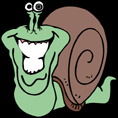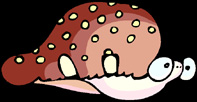|
Snails have prominent tentacles. The tentacles are like two hollow stalks. In many species the eyes are located on these tentacles. Muscles in the snail's body can pull the eyes down the hollow stalks and into the body for protection.
|
 |
|
Snails hibernate in the winter. This means they go to sleep while the weather is very cold. Snails bury themselves and close up the entrance to their shell with a door of slime. This hardens into a tough skin. This tough skin keeps predators out but a tiny hole allows air in. Some snails that live in the desert have been known to remain in their shells for two or three years.
|
 |
|
|
|
|
Snails live for about five years. When they are about three years old they lay eggs. Snail eggs are round and very small. You can find them in clusters of about thirty under stones. Most snails are hermaphrodites.This means they can fertilize their own eggs. |

|
|
Some snails are poisonous and their poison can be fatal to humans. The venom paralyses their prey. These snails are known as Cones and are marine molluscs. Cones live in sandy mud mainly in the tropics and are found on the reefs of Australasia. Cones are very large and their shells are valued by collectors. They have few predators. In Britain it has been observed that thrushes leave yellow-banded snails alone, leading scientists to believe they could be poisonous. This has not been proved- they might just taste bad!!! |
 |